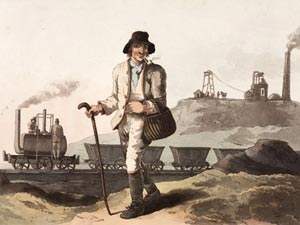
Wikimedia Commons
John Blenkinsop (1783 – 22 January 1831) was a mining engineer and inventor who became steward and agent for Charles Brandling’s coal pits at Middleton near Leeds. He patented a rack and pinion system for a steam locomotive and commissioned the first practical railway locomotive from Fenton, Murray and Wood’s Round FoundryEngineering works off Water Lane in Holbeck, Leeds in Yorkshire, built for Fenton, Murray and Wood. in Holbeck, Leeds in 1811.
Career
John Blenkinsop, the son of a stonemason, was born in Felling near Gateshead in County Durham. He was apprenticed to his cousin, John Straker, the coal viewer for Charles John Brandling’s Felling Colliery. On 1 October 1808 Blenkinsop began work as agent for Brandling’s pits on the Middleton estate near Leeds in Yorkshire. Brandling had offered him a salary of £400, five times what his other experienced colliery workers earned. At the time the Middleton pits were “capable of the greatest Improvement” and that was Blenkinsop’s task. From then until his death, Blenkinsop lived at Middleton Hall,[1] the Brandling’s former home on Town Street which was built in the 17th century.
In addition to managing the Middleton Collieries, Blenkinsop was the consulting engineer for Sir John Lister Kaye of Denby Grange, owner of Caphouse CollieryEx-colliery in Overton, near Wakefield, West Yorkshire, now the National Coal Mining Museum for England. in the 1820s.[2] As a viewer, he was hired by other colliery owners to examine their collieries and report on such vital matters as expected future production and to make suggestions as to how its operation and production could be improved.[3]
In 1825 Blenkinsop was one of the first rescuers to enter Middleton’s Gosforth Pit after an explosion of firedampDamps is a collective name given to all gases other than air found in coal mines in Great Britain. The chief pollutants are carbon dioxide and methane, known as blackdamp and firedamp respectively. , possibly an atributary factor in his death at 47 years of age. He died in Leeds in 1831 after a “tedious illness” and is buried at Rothwell Parish Church.[4][5]
Locomotives
Blenkinsop patented a rack and pinion system for a locomotive in 1811.(Patent No 3431) The locomotive was designed and built by Matthew MurrayMatthew Murray was an engineer born in Newcastle on Tyne who became known for improving steam engines and building the first commercially successful steam locomotive. of Fenton, Murray and Wood in Holbeck.[3][5] SalamancaSalamanca, designed and built by Matthew Murray in 1812, was the world’s first commercially successful steam locomotive., the Murray/Blenkinsop engine, weighed five tons and hauled trains weighing 90 tons. The first locomotive, Salamanca was built in early 1812, another was built later in 1812, the next in 1813 was sent to the Kenton and Coxlodge Waggonway where it was named Willington, and the last in 1815. Robert DaglishRobert Daglish (1779–1865) was a colliery manager, mining, mechanical and civil engineer at the start of the railway era. built the Walking Horse locomotiveLancashire’s first steam locomotive, built by Robert Daglish in 1812 at the Haigh Foundry for colliery owner, John Clarke; it entered service the following year. under licence from Blenkinsop at Haigh Foundry, and another was built by Matthew Murray for the Kenton and Coxlodge Collieries.[5] Two more locomotives were made by the Royal Iron Foundry in Berlin.
The Murray/Blenkinsop locomotives had the first double-acting cylinders, they drove a geared wheel which engaged with the rack beside one rail. One of the geared locomotives was described as having two 8 inch x 20 inch cylinders that drove the wheels through cranks. The piston crossheads worked in guides, rather than being controlled by parallel motion like most early locomotives. The engines saw more than twenty years of service.[6]
George Stephenson observed a ‘Leeds engine’ at Coxlodge Colliery in September 1813 before building his first locomotive, Blucher, which was designed along the lines of the Blenkinsop pattern.[5]

